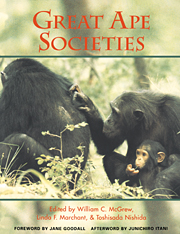Book contents
- Frontmatter
- Contents
- List of contributors
- Preface
- Foreword: conserving great apes
- Part I Apes overviewed
- Part II Social ecology
- Part III Social relations
- Part IV Minds
- Part V Apes compared
- 16 Comparative positional behavior of the African apes
- 17 Nest building behavior in the great apes: the great leap forward?
- 18 Comparative studies of African ape vocal behavior
- 19 On which side of the apes? Ethological study of laterality of hand use
- Part VI Modeling ourselves
- Afterword: a new milestone in great ape research
- Appendix: great ape study sites
- Index
16 - Comparative positional behavior of the African apes
Published online by Cambridge University Press: 04 August 2010
- Frontmatter
- Contents
- List of contributors
- Preface
- Foreword: conserving great apes
- Part I Apes overviewed
- Part II Social ecology
- Part III Social relations
- Part IV Minds
- Part V Apes compared
- 16 Comparative positional behavior of the African apes
- 17 Nest building behavior in the great apes: the great leap forward?
- 18 Comparative studies of African ape vocal behavior
- 19 On which side of the apes? Ethological study of laterality of hand use
- Part VI Modeling ourselves
- Afterword: a new milestone in great ape research
- Appendix: great ape study sites
- Index
Summary
INTRODUCTION
Studies of positional behavior, that is the locomotor and postural behavior of an animal, are generally undertaken in order to understand how variations in postcranial musculoskeletal anatomy are expressed in behavior. For students of human evolution, the positional behavior of the African apes is especially interesting because the defining adaptation in the transition from apes to hominids is a locomotor feature, the advent of bipedalism (see Susman, 1984 for further discussion). Thus, studies of African ape positional behavior are frequently an attempt to elucidate issues that have direct implication for studies of human evolution (e.g. Doran, 1992a, 1993a; Hunt, 1994).
Before the late 1960s, most locomotor information was gathered anecdotally by observers primarily interested in other aspects of primate behavior (e.g. Schaller, 1963; Reynolds & Reynolds, 1965; Goodall, 1968). These studies upset the then-currently held ideas that apes were morphologically adapted as brachiators, and thus, that early hominids evolved from brachiators (see Fleagle et al., 1981; Hunt, 1991 for review). Experimental studies of non-human primate locomotion led Fleagle et al. (1981) to hypothesize that a human ancestor primarily adapted for climbing would show a forelimb morphology similar to that previously associated with brachiation, and a hindlimb morphology that is morphologically and functionally preadapted for bipedalism. They concluded that a climbing theory of human ancestry was more consistent with both experimental and field data. However, at that time, there were few quantitative field data to evaluate their hypothesis.
- Type
- Chapter
- Information
- Great Ape Societies , pp. 213 - 224Publisher: Cambridge University PressPrint publication year: 1996
- 117
- Cited by



